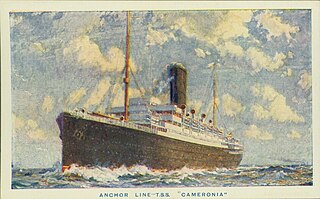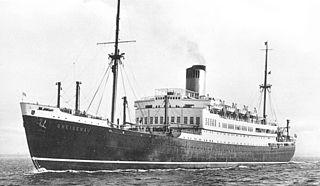
SS John W. Brown is a Liberty ship, one of two still operational and one of three preserved as museum ships. As a Liberty ship, she operated as a merchant ship of the United States Merchant Marine during World War II and later was a vocational high school training ship in New York City for many years. Now preserved, she is a museum ship and cruise ship berthed at Pier 13 in Baltimore Harbor in Maryland.

A Landing ship, infantry (LSI) or infantry landing ship was one of a number of types of British Commonwealth vessels used to transport landing craft and troops engaged in amphibious warfare during the Second World War. LSIs were operated by the Royal Navy, British Merchant Navy, Royal Canadian Navy, Royal Indian Navy, and Royal Australian Navy. They transported British Commonwealth and other Allied troops in sea assaults and invasions throughout the war.

RMS Empress of Japan, also known as the "Queen of the Pacific", was an ocean liner built in 1890–1891 by Naval Construction & Armaments Co, Barrow-in-Furness, England for Canadian Pacific Steamships (CP). This ship – the first of two CP vessels to be named Empress of Japan – regularly traversed the trans-Pacific route between the west coast of Canada and the Far East until 1922. During the First World War she served as armed merchant cruiser, becoming HMS Empress of Japan for the period that she was a commissioned ship of the Royal Navy.
The following is a list of players, both past and current, who appeared at least in one game for the Los Angeles Dodgers National League franchise (1958–present), and for the Brooklyn-based teams known as the Atlantics (1884), Grays (1885–1887), Bridegrooms, Grooms (1891–1895), Superbas (1899–1910), Dodgers and Robins (1914–1931).
SS George Calvert was a Liberty ship built in the United States during World War II. She was named after George Calvert, an English politician and colonizer. Calvert took an interest in the British colonization of the Americas, becoming the proprietor of the Province of Avalon, the first sustained English settlement on the southeastern peninsula on the island of Newfoundland. He later sought a new royal charter to settle the region, which would become the state of Maryland.

SS Friedrich der Grosse was a Norddeutscher Lloyd liner built in 1896 which sailed Atlantic routes from Germany and sometimes Italy to the United States and on the post run to Australia. At the outset of World War I the ship was interned by the U.S. and, when that country entered the conflict in 1917, was seized and converted to a troop transport, becoming USS Huron (ID-1408).

USS George F. Elliott (AP-105) was a cargo liner built for the Mississippi Shipping Company as SS Delbrasil for operation between New Orleans and the east coast of South America in 1939 by its operator, Delta Line. The ship entered that service and operated until taken over by the War Shipping Administration (WSA) on 28 April 1942 for operation by Delta Line acting as WSA's agent. On 25 August 1943 WSA allocated the ship to the Navy for conversion to a troop transport commissioned and operated by the Navy for the duration of the war. Ownership of the ship was transferred from Mississippi Shipping to WSA on 4 February 1944 while under Navy operation and was retained until sale to American South African Lines on 22 December 1948. The ship was renamed African Endeavor until returned as a trade in to the Maritime Commission on 22 September 1960 for layup in the James River reserve fleet and later sold to Boston Metals for scrapping.

RMS Empress of India was an ocean liner built in 1890-1891 by Naval Construction & Armaments Co, Barrow-in-Furness, England for Canadian Pacific Steamships. This ship would be the first of two CP vessels to be named Empress of India, and on 28 April 1891, she was the very first of many ships named Empress arriving at Vancouver harbor.

Short Brothers Limited was a British shipbuilding company formed in 1850 and based at Pallion, Sunderland since 1869. The company closed in 1964 when it failed to invest to build bigger ships.

SS Letitia was an ocean liner built in Scotland for service with the Anchor-Donaldson Line. She continued to serve with its successor company Donaldson Atlantic Line. At the start of the Second World War in September 1939, the British Admiralty requisitioned the ship for service and had it converted to serve as an armed merchant cruiser. She was withdrawn from this service in 1941 to become a troop ship.

Cameronia was a British ocean liner which was built in 1920 by William Beardmore & Co Ltd, Dalmuir for the Anchor Line. She was requisitioned for use as a troopship in the Second World War, surviving a torpedo attack. In 1953 she was requisitioned by the Ministry of Troop Transport (MoTT) and renamed Empire Clyde. She was scrapped in 1957.

SS Gneisenau was a 18,160 GRT Norddeutscher Lloyd ocean liner that was launched and completed in 1935. Like several other German ships of the same name, she was named after the Prussian Generalfeldmarschall and military reformer August Neidhardt von Gneisenau (1760–1831).

Western Maid was a 5,760 GRT cargo ship that was built in 1918 by the Northwest Steel Company, Portland, Oregon, USA. She was built for the United States Shipping Board (USSB), but was commissioned into the United States Navy on completion as USS Western Maid, with the pennant number ID-3703. In 1919 she was decommissioned and returned to the USSB. In 1937 she was passed to the United States Maritime Commission. In 1940 she was transferred to the British Ministry of Shipping and renamed Empire Cormorant, passing to the Ministry of War Transport (MoWT) in 1941. In 1945 she was scuttled in the North Atlantic with a cargo of obsolete war matériel.
Mayasan Maru (摩耶山丸) was a Japanese landing craft depot ship used extensively to transport Imperial Japanese Army (IJA) troops during 1943 and 1944. After avoiding damage in seven separate submarine attacks in earlier convoys, she was sunk in the East China Sea by the submarine USS Picuda on 17 November 1944 while part of Convoy Hi-81. The sinking caused one of the highest maritime casualty counts of World War II. Some 3,536 lives were lost.

MV B. P. Newton was a Norwegian tanker built in 1940, and sunk by German submarine off South America in July 1943.

SS Cathay was a British passenger ship that was sunk during Operation Torch in 1942 by a German air raid in the Mediterranean Sea off Bougie, Algeria.

The SS Pere Marquette was the world's first steel train ferry. It sailed on Lake Michigan and provided a service between the ports of Ludington, Michigan, and Manitowoc, Wisconsin, for the Pere Marquette Railway from 1897 to 1930. The railway used the name Pere Marquette for many of its ships and ferries, adding a number to the end of the name.













